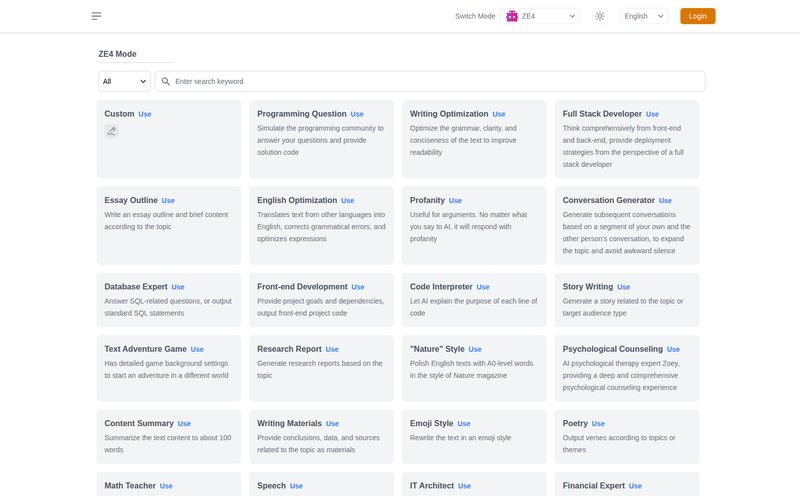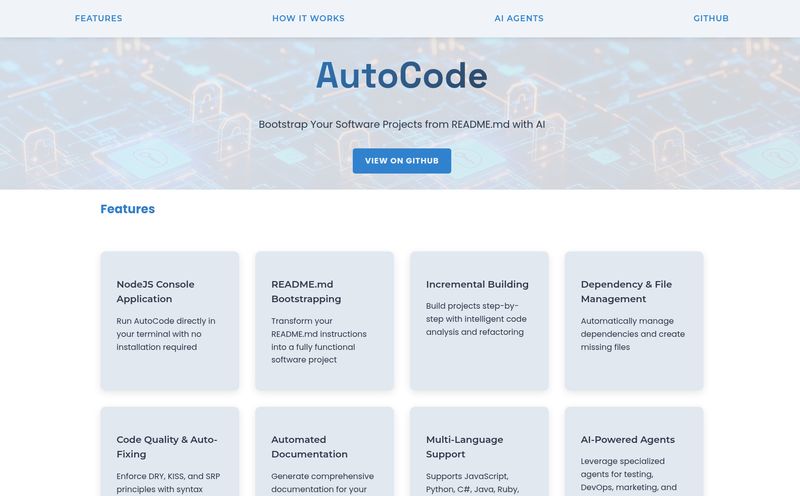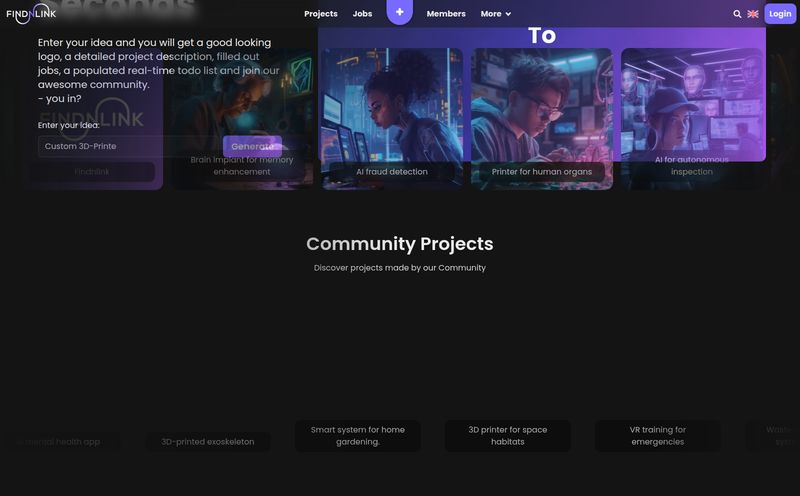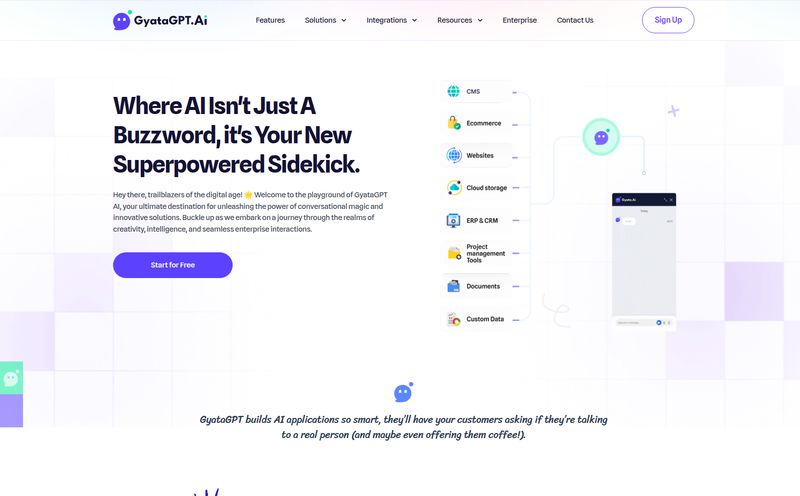The term 'AI' is getting thrown around more than a frisbee at a college picnic. Every other SaaS tool, marketing platform, and to-do list app is suddenly “AI-powered.” It’s a lot of noise. And for business owners and execs, it's starting to sound like a whole lot of nothing.
I've been in the SEO and digital growth world for years, and I’ve seen these hype cycles before. Remember the 'Big Data' explosion? Or when every company had to have a mobile app, even if it was just a clunky version of their website? The AI wave feels like that, but on steroids. The problem is, while the potential is massive, the practical path forward is… well, foggy at best.
Most of us are stuck wondering: How do I actually use this stuff to make more money or save more time? Not just to generate a funny cat picture, but to genuinely move the needle. That’s the gap where a company like Dreamline seems to be planting its flag. I’ve been looking at what they do, and it’s a refreshingly different approach.
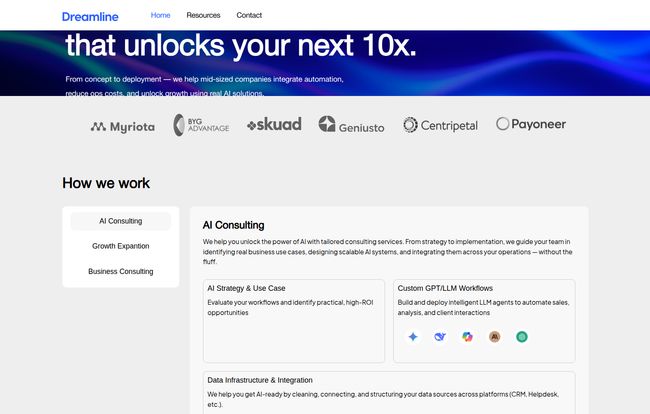
Visit Dreamline
So, What Exactly is Dreamline?
In a nutshell, Dreamline is an AI consultancy. But that description feels a little flat. It’s not a software you subscribe to. It’s a team of people you hire to be your AI-focused strategic partners. Think of them less as tool-sellers and more as architects and engineers for your business operations. They come in, look at your existing processes, and design a blueprint for integrating real, functional AI to make things better, faster, and smarter.
Their whole pitch revolves around three core areas:
- AI Consulting: Figuring out where AI can actually help you, not just where it sounds cool.
- Growth Expansion: Using AI and data to build a killer Go-To-Market (GTM) strategy.
- Business Consulting: Cleaning up your data and systems so that automation can even work in teh first place.
This isn't about plugging in a single, magical API. It's about designing and integrating whole systems, from custom GPT/LLM workflows to automating sales analysis. It’s the grown-up version of “using AI.”
Finally, Some Strategy Without the Fluff
What caught my eye is their explicit focus on “no-BS guidance.” Hallelujah. We’ve all sat through demos where a vendor promises their AI will “revolutionize our synergy” and you walk away with no idea what it actually does. Dreamline seems to start with the problem, not the solution. They call it “Opportunity Mapping.”
This is where they diagnose your operational bottlenecks and find the specific, high-ROI spots where an AI intervention makes sense. It’s the difference between a doctor giving you a bottle of multivitamins for a broken leg versus actually setting the bone. One is a generic solution, the other is a targeted, effective treatment.
For example, they mention identifying opportunities to automate sales, analyze customer interactions, and build custom workflows. This is the practical stuff that actually saves money and drives revenue. I’ve seen so many companies jump to build a fancy chatbot when what they really needed was an automated system to qualify leads from their CRM data.
A Look Under the Hood at Dreamline's Services
Let's break down what they actually seem to do for their clients. It’s not just one thing, but a connected process.
AI Strategy and Systems Design
This is the blueprint phase. They don’t just hand you a list of tools. They design the entire workflow. How does data from your CRM (like Salesforce) get analyzed? How do insights from customer support tickets (from a platform like Zendesk or Helpdesk) get turned into actionable tasks? They design the full data pipeline and AI system, complete with a roadmap, clear cost estimates, and an implementation timeline. This is the heavy lifting most businesses simply don’t have the in-house expertise for.
Growth Expansion and Go-To-Market Strategy
As an SEO guy, this part really speaks to me. A GTM strategy is everything. You can have the best product in the world, but if you can’t reach the right people efficiently, you’re dead in the water. Dreamline uses data and AI to sharpen that spear. This could mean anything from creating intelligent lead scoring models to automating market research or optimizing outreach campaigns. They work with a range of industries—Tech & Software, Financial Services, Web3, Cyber Security—that are all hyper-competitive. In these fields, a data-driven GTM strategy isn't a nice-to-have; it's a survival mechanism.
Build, Integrate, and Execute
Here's where the rubber meets the road. They don't just give you a plan and walk away. They actually build the AI systems and integrate them with your existing platforms. The testimonial from John Fargis of OTG Advantage on their site says it all: "They brought clarity, expertise, and a no-nonsense approach... They helped us put systems into systems that actually moved the needle." That last part is golden. “Moving the needle” is what matters, not just adding another piece of software to your tech stack.
Let's Talk About the Investment
So, what does this all cost? You won’t find a neat little pricing table on their website with three tiers. And that’s to be expected. This isn't a $49/month SaaS subscription. This is high-touch, bespoke consulting.
The cost will depend entirely on the scope of the project. A full GTM strategy overhaul with custom AI integrations for a large enterprise is going to be a significant investment. A smaller project to automate one specific workflow for a mid-sized company will be less. You'll have to get in touch with them for a quote.
This model isn’t for everyone. If you’re a solo founder or a tiny startup on a shoestring budget, this is probably out of reach. But for established businesses struggling to scale or larger companies feeling the pressure to innovate, the ROI from this kind of strategic partnership could easily dwarf the upfront cost.
| The Good Stuff | Things to Consider |
|---|---|
| Strategic, not just tactical. They focus on the 'why' and 'how,' not just the 'what.' This is real consulting. | It's a premium service. The custom nature means it's not going to be cheap. Expect enterprise-level pricing. |
| Experienced, no-nonsense team. Their approach feels grounded and practical, a welcome change from the AI hype. | Results depend on you, too. The success of the project relies on the quality of your existing data and your team's implementation. |
| End-to-end execution. They don't just consult; they design, build, and integrate. | Opaque pricing. You have to engage with them to understand the potential cost, which can be a hurdle for some. |
Frequently Asked Questions about Dreamline
I can already hear the questions bubbling up, so let's tackle a few common ones.
1. What exactly is Dreamline in simple terms?
Think of them as a special-ops team for your business. They come in, find the biggest opportunities for improvement, and then build and install custom AI-powered systems to automate tasks, improve your marketing, and help you make smarter decisions.
2. Who is the ideal client for Dreamline?
Based on their website and approach, their ideal client is likely a mid-sized to large business, especially in sectors like Tech, SaaS, Finance, or Cyber Security. These are companies that have complex operations and enough scale to see a massive ROI from strategic automation and data intelligence. They're for businesses that are ready for a serious strategic investment, not just a quick fix.
3. How is this different from just hiring a freelance developer or buying an AI tool?
A freelance developer can build what you tell them to, but they might not have the strategic business sense to tell you what you should be building. An off-the-shelf AI tool is a one-size-fits-all solution that may not fit your unique processes. Dreamline combines the strategy (the 'what' and 'why') with the technical execution (the 'how').
4. What kind of results can I realistically expect?
The goal is tangible business outcomes: reduced operational costs from automation, increased revenue from a smarter GTM strategy, and better decision-making from clean, accessible data. The client testimonial points to them "moving the needle," which implies measurable improvements in core business metrics.
5. Is their focus more on growth or on cost-cutting?
It seems to be both, which is the smart way to do it. They talk about “Eliminate Costs, While Enjoying Scale.” They use automation to make your operations more efficient (cost-cutting) and use data intelligence to power your growth strategy (revenue generation). The two go hand-in-hand.
My Final Take
Look, the AI landscape is confusing. It’s a jungle out there. Most of us don’t need another tool; we need a guide. Dreamline seems positioned to be that guide for a very specific type of company.
If you're a business that has outgrown simple tools and needs a cohesive, intelligent strategy to get to the next level, their approach makes a lot of sense. It’s about building a sustainable, data-driven engine for growth, not just chasing the latest tech trend. It's a serious solution for serious businesses. And in today's noisy market, that kind of clarity is worth its weight in gold.
Reference and Sources
- Dreamline Official Website
- How to Get Your Company Ready for AI - Harvard Business Review (Example authoritative link)
